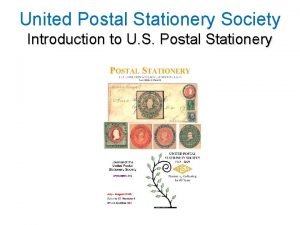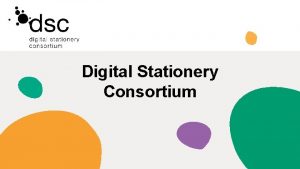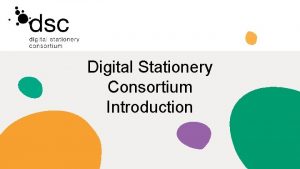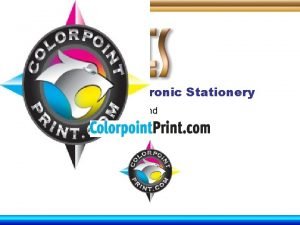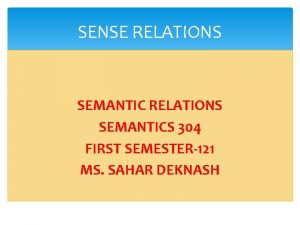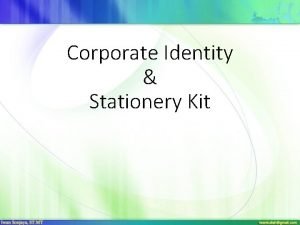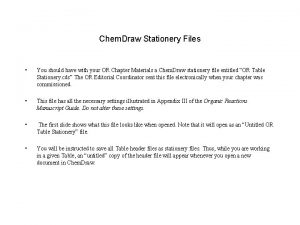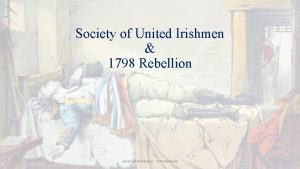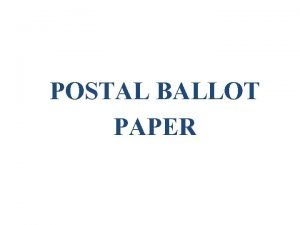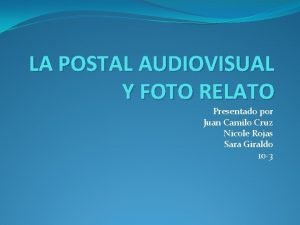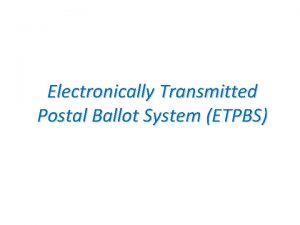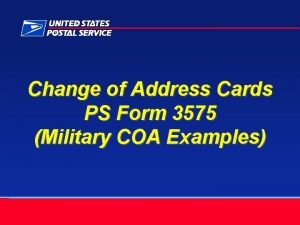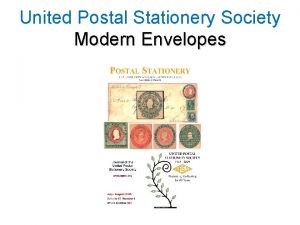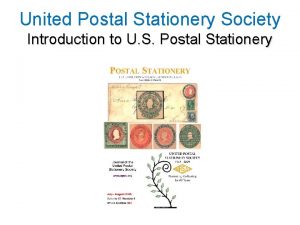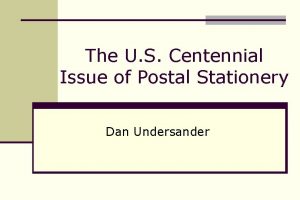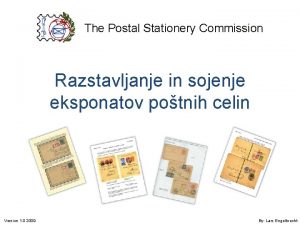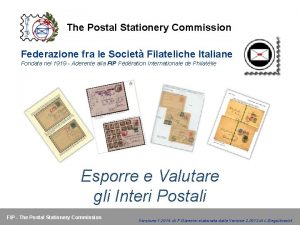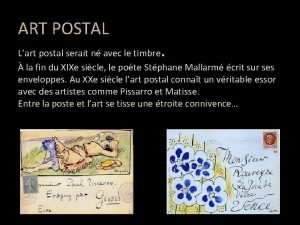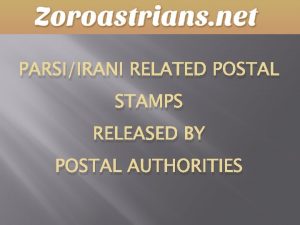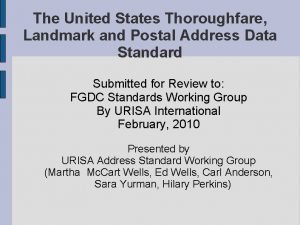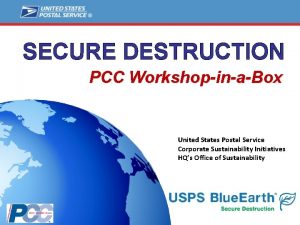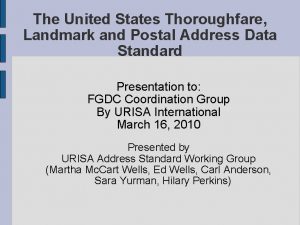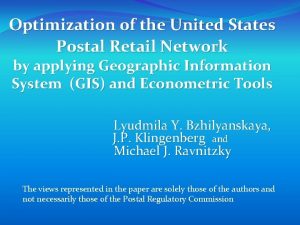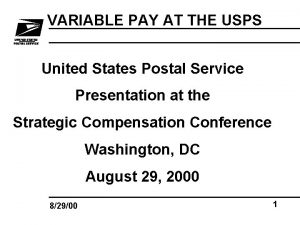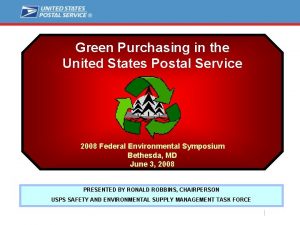United Postal Stationery Society Introduction to U S




















- Slides: 20

United Postal Stationery Society Introduction to U. S. Postal Stationery

Postal Stationery is postal matter which has either an v officially authorized pre-printed stamp or v inscription indicating that a specific face value of postage or related service has been prepaid“ Envelopes with these stamps are all considered Postal Stationery since a specific face value of postage has been prepaid.

Postal Stationery is postal matter which has either an v officially authorized pre-printed stamp or v inscription indicating that a specific face value of postage or related service has been prepaid“ These envelopes do not have a stamp with specific face value and are not considered to be postal stationery (even though the official postal service envelope at lower left is listed in many catalogs).

Introduction v The earliest items of U. S. postal stationery were envelopes. v The other forms of U. S. postal stationery include: v wrappers (newspaper bands), v postcards, v letter cards, and v air letter sheets (aerograms) v Other types of documents (such as registration envelopes and certificates of posting) bearing impressions of postage stamp designs have been produced by other countries.

Introduction to U. S. Envelopes • The first American envelope was developed in 1839. – Until 1847, postage was charged by the number of sheets as well as the distance to be traveled. Thus use of an envelope doubled postage. This and paper shortages caused few envelopes to be used. • The first U. S. Postal envelope was produced in 1853. • Postal Stationery collecting encompasses the indicia (stamp) as well as the differing envelopes on which the stamp appears. – attributes necessary to identify the envelope include size, knife, paper type, gum type, watermark and recycle logo.

Envelope Size About 25 sizes of U. S. stamped envelopes have been produced. The Postal Service now uses 3 basic sizes for modern envelopes – v 6¾ - 165 mm by 92 mm v 9 – 225 by 98 mm v 10 – 241 by 105 mm UPSS size 12 UPSS size 21 UPSS size 23 The UPSS has established a unique number for each size to allow comparison historically when the Post Office changed size designations.

Envelope Knife is the overall shape of the envelope prior to folding. Originally, the knife was a cookie cutter type mold used to cut the actual blank envelope shape. The knife would be laid on a pile of sheets and cut around with a sharp knife in early years or pushed through the paper with a hydraulic press in later years. Now envelopes are cut from paper rolls by rotary knives. However, the term is still used to refer to the shape prior to folding.

Modern Envelope Knives Top Flap Left Flap Right Flap Bottom Flap Knife 69 (with window) Left Flap Knife 70 (plain front)

Envelope Paper Two basic types of paper – Laid and Wove – have been used to U. S. produce envelopes. Paper is manufactured by placing a paper mash thinly on a woven wire mesh. Water is removed and the paper is dried. Laid paper shows a watermark of parallel lines close together when held to a light. The lines may either be horizontal, vertical or diagonally. Horizontally Laid Wove Paper Diagonally Laid Wove paper is similarly produced however the wires of the mesh are interwoven much like a screen. This paper has a mottled appearance and was produced as both standard or extra quality paper which can be differentiated by either weight or thickness.

Watermarks are impressions made when paper is manufactured as a security device and are visible as lighter areas when paper is held to a light. Watermark 30 Watermark 48 Watermarks were produced by soldering bent wires onto a mesh cylinder. Then the paper mash was applied and the raised areas of the cylinder transferred to the paper as thinner areas. Watermark designs changed with each new envelope contract in the U. S. until 1961. Watermark 51 Use of watermarked paper ceased with the introduction of recycled paper in the 1990 s.

Paper Color Envelope paper colors varied throughout production. They include white, amber, oriental buff, fawn, blue and manila. Manila is a paper type more than a color, is cheap and of low quality. White Blue Amber Manila Oriental Buff Fawn A color chart is shown on the next slide that can assist in the identification of the various envelopes used with the different colored paper.

Paper Color Chart

Embossed Envelope Dies are used to create the impressions on the envelope. They are hand engraved in reverse on a steel block. These Master dies are hardened and then used to produce Hub dies which in turn are used to make the working dies used during production of the envelopes. Although the images that appear on modern envelopes are still referred to as dies, modern envelopes no longer are printed from embossed dies. Since the 1970’s stamps have been largely surface printed on envelopes

Surface Printed Dies Lithography uses chemical processes to create an image. For instance, the positive part of an image is a water-repelling substance, while the negative image is water-retaining. Thus, ink will adhere to the positive image and be transferred to the paper.

Surface Printed Dies Topographic printing is the exact opposite of engraved printing. The ink for the stamped area is applied directly to the raised portion of a plate for transfer to the envelope.

Surface Printed Dies Flexographic printing is a form of rotary web letterpress, combining features of both letterpress and rotogravure printing, using relief plates of flexible rubber or photopolymer and a fast drying, low viscosity solvent, waterbased or UV curable inks. Flexographic Plate

Gum (Adhesive) Gum is used to keep the envelope together by adhering the side and bottom flaps to one other while the gum on the top flap remains unadhered to allow the user to seal the envelope after the contents have been inserted. Originally, gum was applied by hand until the equipment to do it mechanically was developed. Currently, two basic types of gum are used – water activated which requires adding moisture and pressure sensitive which only requires a peel and press operation. Hand Gummed (Square Gum) Machine Gummed (Round) Pressure Sensitive Adhesive Peel Strip

Early Recycle Logos In an effort to exhibit a more environmentally friendly awareness, the Postal Service required that envelope paper contain varying amounts of recycled paper along with the virgin fiber. To reflect this commitment, recycle logos with various text and compliance symbols are depicted on the envelopes. There are 21 different logos. Examples of some are shown below. Recycle Logo E Recycle Logo A Recycle Logo C Recycle Logo I

Modern Recycle Logos Recycle Logo J Recycle Logo L Recycle Logo M Recycle Logo O Recycle Logo U The Sustainable Forest Initiative (SFI) emblem was added to the logo in May, 2009. In January, 2010, the Cradle to Cradle (CTC) emblem was added to the right of the SFI emblem. Another change occurred in January, 2011 when the CTC emblem was moved to the far right of the entire logo string. Then in June, 2012 the CTC emblem was found to be missing from the logo altogether. In January 2015, a new certification was used from the Forestry Stewardship Council replacing the SFI emblem. This change occurred due to a change in the paper supplier

United Postal Stationery Society catalogs are a one source reference for all postal stationery listings including illustrations, prices, knives, logos and more. Begin your collecting experience by obtaining a catalog now and joining the United Postal Stationery Society today! What may look like an everyday item could be something more valuable than imagined! Order printed or electronic books from the Society website at: www. upss. org
 Chemdraw stationery document
Chemdraw stationery document Digital stationery
Digital stationery Felix obschonka
Felix obschonka Electronic stationery
Electronic stationery Superordinate and hyponym
Superordinate and hyponym Stationery kit adalah
Stationery kit adalah Chemdraw stationery document
Chemdraw stationery document Chemdraw stationery document
Chemdraw stationery document Tas bdm
Tas bdm The society of united irishmen
The society of united irishmen Electronic contract law
Electronic contract law Henthron v fraser
Henthron v fraser Tarsila do amaral postcard
Tarsila do amaral postcard Postal industry trends
Postal industry trends Postal ballot paper format
Postal ballot paper format Postal audiovisual
Postal audiovisual Eco postal staff college
Eco postal staff college Handwritten alphabet recognition
Handwritten alphabet recognition Cusitm
Cusitm Electronically transmitted postal ballot system
Electronically transmitted postal ballot system Usps form 3575 download
Usps form 3575 download
